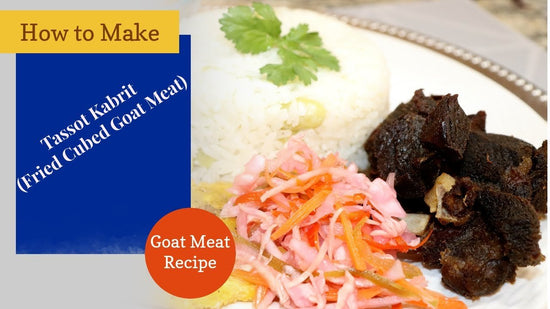Building Your Haitian Pantry
A Haitian kitchen always has flavor on standby. These are the staples you’ll see again and again throughout this book and in homes across Haiti and the Haitian diaspora:
- Rice (Diri – dee-ree): Long-grain or jasmine rice, the base of many dishes.
- Beans (Pwa – pwah): Black, red, or kidney beans — often simmered in seasoned water for diri kole.
- Epis (Ay-pees): The seasoning blend that defines Haitian cooking. Our dry blend makes it easy to use any time.
- Plantains (Banan – bah-nahn): Green for frying, ripe for sweetness.
- Scotch Bonnet Peppers (Piman – pee-mahn): Adds heat and aroma.
- Thyme (Tim – teem): Used in soups, stews, and sauces.
- Limes (Sitwon – see-twon): Used to clean and marinate meats.
Each of these ingredients is part of the rhythm of Haitian cooking — simple, practical, and packed with meaning.
Haitian Epis and Caribbean Marinating Traditions
No Haitian pantry is complete without Epis. This flavorful Creole seasoning brings depth to meats, seafood, and vegetables. It’s the foundation of soups like bouyon bèf and dishes like griot or tasso.
Our Epis Dry Blend (Mild) captures the full taste of fresh epis, bell pepper, garlic, herbs, and bouillon — in an easy, shelf-stable form. The Epis Dry Blend (Hot) adds the same balance of flavor with the kick of habanero pepper.
Use either to season meats before frying or baking, or to enrich stews and marinades.
You can find a bottle of our Epis Dry Blends on our website: dinnerideascollective.com
Vocabulary and Haitian Food Names
Understanding Haitian food names connects you deeper to the culture behind every meal. Here’s a guide you can reference while reading Dinner Ideas for the Haitian Cook – Second Edition:
A
- Anana – Pineapple – ananas (French)
- Auberres à l’Haïtienne – Eggplant stewed with beef
- Avwa-n – Wheat
B
- Banann – Plantains – bananes (French)
- Banann peze – Twice-pressed fried plantains
- Banann bouyi – Boiled plantains
- Bef Salé – Dried and fried beef
- Benye – Banana fritters
- Ble – Wheat (meal)
- Boeuf à la Haïtienne – Beef with tomatoes and peppers
- Boulet – Meatballs
- Bouquet Garni – Bundle of herbs for soups and stews
- Bouyon – Soup with vegetables, meat, roots, and herbs
- Bouyon bèf – Beef soup
- Bouyon kabrit – Goat soup
- Bouyon krab – Crab soup
- Bouyon lambi – Conch soup
- Bouyon pye bèf – Cow’s feet soup
- Bouyon tèt kabrit – Goat’s head soup
C–F
- Calaloo – Spinach-like greens used in legim
- Chayotes – Mild squash, also called mirliton
- Chou – Cabbage – chou (French)
- Confiti Mango – Mango chutney
- Diri Blan – White rice
- Diri Kole – Rice cooked with beans
- Diri ak Djon-djon – Rice with dried black mushrooms
- Diri ak Pwa – Red beans and rice
- Donbwèy – Rolled flour cooked in bouyon
- Dous Kokoye – Coconut milk candy
- Epis – Creole spice blend – épices (French)
- Fig – Banana
- Griot – Fried or baked seasoned pork or goat
- Gwayav – Guava – goyave (French)
- Ji Chadek – Grapefruit juice
- Jiwòf – Clove – girofle (French)
K–P
- Kasav – Cassava bread
- Kenèp – Honey berry (ginep) – quenèpe (French)
- Kokoye – Coconut – noix de coco (French)
- Konfiti Anana – Pineapple preserves
- Kremas – Haitian cream liqueur
- Lambi – Conch – conque (French)
- Makaroni Gratinen – Macaroni and cheese
- Malanga – Taro root
- Mambá – Spicy peanut butter
- Mayi Moulen – Cornmeal mush
- Pikliz – Spicy pickled vegetables
- Piman – Pepper – piment (French)
- Pwa ansòs – Beans with sauce
- Poul ak sòs – Chicken with sauce
- Pwason – Fish
S–Z
- Sauce Ti-Malice – Hot pepper sauce
- Sitronad – Lemonade
- Soup Joumou – Squash soup
- Tasso – Dried and seasoned beef or goat
- Tomat – Tomato – tomate (French)
- Veritab Fri – Fried breadfruit
- Yanm – Yam – igname (French)
- Zaboka – Avocado – avocat (French)
- Zanmann – Almond – amande (French)
These terms appear throughout our cookbook — a bridge between language and flavor that helps readers cook with confidence and connection.
Commonly Used Kitchen Equipment
Before you start cooking, make sure your kitchen is ready. Here’s a layout of commonly used tools found in Haitian kitchens:
|
Mortar and pestle (Pilòn) |
|
|
|
Cast-iron pot (Chodyè) |
|
|
|
Deep frying pan |
|
|
|
Wooden spoon |
|
|
|
Fine grater |
|
|
|
Mixing bowls |
|
|
|
Measuring spoons and cups |
|
|
|
Strainer |
|
|
|
Pressure cooker |
|
|
|
Blender or food processor |
|
|
These tools make it easier to prepare traditional dishes like bouyon, diri ak pwa, and griot with the right texture and flavor.
Bringing It All Together
Your pantry is more than ingredients; it’s a link to heritage. The second edition of Dinner Ideas for the Haitian Cook walks you through the recipes, flavors, and vocabulary that define our food traditions.
When you season your dishes with Epis Dry Blend (Mild or Hot), you’re adding the same base flavors that Haitian families have used for generations.
You can find a bottle of our Epis Dry Blends on our website: dinnerideascollective.com

















